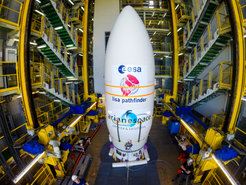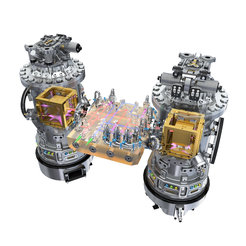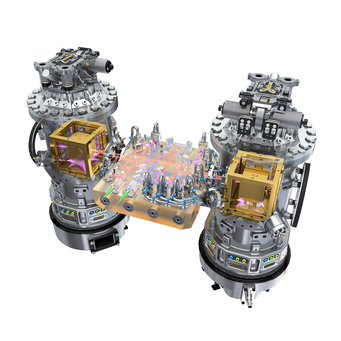LISA Pathfinder – the countdown is running
AEI researchers are leading partners in LISA Pathfinder satellite mission scheduled for launch on December 2
At 5:15 CET on December 2, a Vega rocket is scheduled for launch from the European spaceport in Kourou (French Guiana) to lift a “pathfinder” into space: LISA Pathfinder will demonstrate novel technologies for the planned gravitational-wave observatory eLISA that will one day capture the sound of the Universe. The LISA Pathfinder project is based on more than ten years of scientific development and progress. The Max Planck Institute for Gravitational Physics (Albert Einstein Institute) in Hannover is one of the leading mission partners.
Important update: Due to technical difficulties with the launcher rocket, the LISA Pathfinder launch will be postponed to after December 2 by at least one day. A decision about a new launch date is expected on December 2.
“With LISA Pathfinder we will demonstrate crucial technologies for future missions such as eLISA and will be one large step closer to the detection of gravitational waves from space“, says Prof. Dr. Karsten Danzmann, director at the Albert Einstein Institute and professor at Leibniz Universität Hannover.

Free fall at the Lagrange point
After its launch on December 2, LISA Pathfinder (LPF) will be in a near-Earth parking orbit and will separate from the launcher after two hours. Starting on December 6, a series of six thruster burns will repeatedly raise the orbit's apogee within five days.
After this, LPF will leave orbit around the Earth and drift on a transfer orbit towards the Lagrange point L1, 1.5 million kilometers from Earth towards the Sun. After about 40 days the satellite will arrive there and assume an orbit around L1. This offers ideal conditions for LISA Pathfinder's main task: releasing two test masses in perfect free fall and to measure and control their positions with unprecedented precision.
This is achieved through state-of-the-art technology comprising inertial sensors, a laser metrology system, a drag-free control system and an ultra-precise micro-propulsion system. All these technologies are essential for eLISA.

Two cubic test masses
During the main mission, each of the separate vacuum tanks inside the LPF scientific payload will house one of two-kilogram cubic test mass. They will fall freely inside the satellite, protected from all inner and outer disturbances and will demonstrate the precise measurement and control of force-free motion.
A laser interferometer will measure the position and orientation of the two test masses relative to the spacecraft and to each other with a precision of approximately 10 picometers (one hundred millionth of a millimetre). The construction of the precise optical measurement system was lead by the Max Planck Institute for Gravitational Physics (Albert Einstein Institute) in Hannover. Prof. Dr. Karsten Danzmann also is the Co-Principal Investigator for the LISA Pathfinder Technology Package, the scientific heart of the satellite.
Data analysis in Hannover
The main scientific mission of LISA Pathfinder begins on March 1, 2016 and will last for at least six months. During this time, the researchers will conduct several series of consecutive experiments, depending on one another. These experiments will measure the near-perfect free fall by determining non-gravitational parasitic accelerations, identifying important sources of disturbances and further minimizing those if necessary.
The Max Planck Institute for Gravitational Physics in Hannover is one of the leading partners in the development of the data analysis software which plays a central role in extracting the crucial information from the measurement data. For this purpose the institute has set up an operations control room in Hannover. Since an immediate data analysis is required for the configuration of follow-up experiments, scientist from the institute will also take part in the around-the-clock shifts in the European Space Operations Centre (ESOC) in Darmstadt, Germany.













